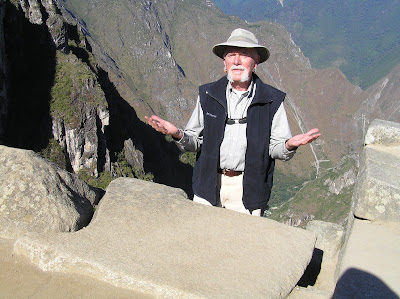 |
| The main door into the city of Machuu Picchu. The stairs leading down from the guard house, provided access. How, and with what this door might have been closed is a mystery. |
 |
| On either side of the door that provides entrance into the city, are round rocks that seem to form some type of locking mechanism. How did they work? No one knows for sure. |
 | |||
| In the forground, the living quarters of the Inka King and the nobility. On the right, as one moves toward the sacred mountain of Waynapicchu, is the industrial area of the city. | |
 | ||
| A closer view of the residential area. |
 | |||
| During the Inca time, these houses would have been covered with thatch roofs. |
 |
| The Inca were experts at masonery. These rocks were laid one on top of the other, still standing 500 years later. And this is not even the best example of the stonework of the Inca! |
 |
| The industrial area, as viewed from on top of the sacred temple are of the city. |
 |
| To get to the relgious and industrial parts of the city, one walks past many terraces, stone walls, and the Temple of the Sun. |
 | ||
| The Temple of the Sun is a very refined form of stonework. Not the precision of the rocks and the round curves of the rock that form this temple. |
 |
| The Temple of the Sun was an important temple in the city, but it was not the most important. |
 | |||
| Directly under the structure of the Temple of the Sun, was the Temple of the Mother Eearth. |
 | |||
| Located next to the Temple of the Sun, was the Water Temple. |
 |
| Acquaducts carried water from the moutnains, to all parts of Machuu Picchu. |
 |
| The stonework that went into the construction of the acquaducts is amazing. |
 |
| The head of the condor in the Condor Temple. |
 |
| The top left side of the city of Machuu Picchu was the mose sacred part of the city. |
 |
| The most important temple at Machuu Picchu, facing the city plaza or square. |
 |
| Yes ..... the drop behind me into the valley below...... thousands of feet! Why....? Why... do I do these things |
 |
| Machuu Picchu..... truly a wonder of the world! |











1 comment:
Great bloog I enjoyed reading
Post a Comment